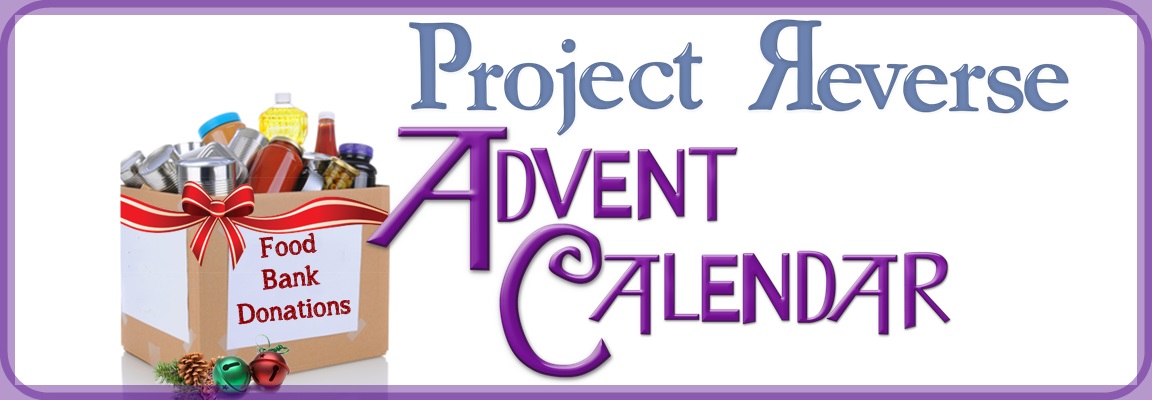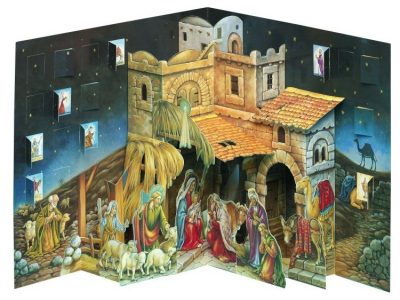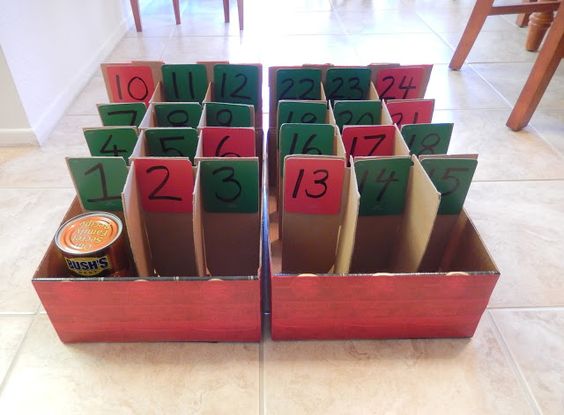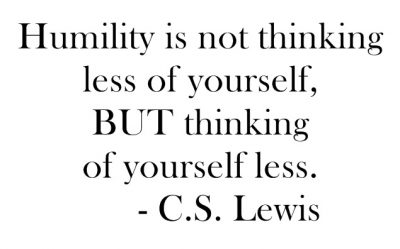Project Reverse Advent Calendar

 Advent Calendars are used to count-down the days of Advent leading up to Christmas Eve. At the time they were first introduced, in the late 19th or early 20th century, the opening of a “window” on each of the days might reveal a picture, a prayer or a quotation from Scripture appropriate to incorporate into daily Advent devotions. The Historical Dictionary of Lutheranism [Scarecrow Press, 2001] suggests that the daily opening of a “window” is representative of the letting in of the light of Truth ‘bit by bit’ until the arrival of Him who is the ultimate Light of the World – Jesus Christ.
Advent Calendars are used to count-down the days of Advent leading up to Christmas Eve. At the time they were first introduced, in the late 19th or early 20th century, the opening of a “window” on each of the days might reveal a picture, a prayer or a quotation from Scripture appropriate to incorporate into daily Advent devotions. The Historical Dictionary of Lutheranism [Scarecrow Press, 2001] suggests that the daily opening of a “window” is representative of the letting in of the light of Truth ‘bit by bit’ until the arrival of Him who is the ultimate Light of the World – Jesus Christ.
Of late, Advent calendars have, like many of our long-standing traditions, become commercialized to the point that some of the reasons for their development have been lost. Initially, one of the changes was to have illustrations of a more secular nature – moving away from traditional scenes portraying the Nativity, or a church exterior or interior, to ones focused on Santa Claus, the North Pole or some other scene that did not illustrate aspects of the Scripture based story to ones that fit in more with a modernized version that appealed to a wider audience. Today many businesses issue their version of these calendars – often giving them non-Christian titles like “Count down calendar”, “Seasonal Count down”, etc. One of the other major changes is that the opening of each window provides one with a “reward” of some sort – everything from chocolate, tea, jewellery, figurines, toys and, beer can be found waiting for the owner of the calendar.

This is a suggested Reverse Advent Calendar. Boxes that are made for transporting bottles often come with dividers for 12 spaces. Or, just use a plain box, basket or any container.
Very recently, in an attempt to refocus the tradition of Advent calendars on preparing ourselves for the coming of our Eternal King, suggestions have been made on how to change the modern trend away from us getting something to giving something. One of the suggestions that has been capturing the imagination of some of us is the idea of a “Reverse Advent Calendar”. Julie Van Rosendaal, a Canadian writer, editor and ‘food personality’ is one of the people being credited with the growth of this idea. In an interview Van Rosendaal said: “There are so many advent calendars out there, and who needs more chocolates or little plastic toys? It’s the counting down to Christmas that’s exciting, not the waxy little chocolate. What better reminder that Christmas is all about giving and sharing the love?” [see the Eat North website for more of this interview by clicking here.]. In yesterday’s post, “Are we ready yet?, we were reminded that we meet Christ in everyone – especially those who stand in need of the same love we do. That need may be a struggle to “make ends meet” and put meals on their table.
At all times God calls us to an attitude of compassion, forgiveness, mercy and help. This is what He has always shown to us. God’s call to the church is to identify with the poor, the weak, and the vulnerable, and to invest our time, energy and money in serving them. Our challenge is to make our actions become an expression of our love for God and a reflection of God’s love towards all of us. It is not just a religious duty or obligation, but a privilege to serve that naturally flows out of our relationship with God.
 This Advent, our parish is taking part in its own “Project Reverse Advent Calendar”. In our own homes, as a part of our daily devotions, we are being challenged to collect one non-perishable item each day to donate to one of our local food banks. Each Sunday, those participating will collect up the week’s worth of donations and bring them to church to be put in a container together with items from other parishioners. The growing collection of items will, hopefully, prove a witness to our growth this Advent Season offers us – growth in Love and outreach. As we collect the items at home we can use it as a reminder to pray for the work of the food banks and the volunteers that make them possible. If you are involving children – including your grandchildren or God-children – let them be a part of selecting the item. Have them tell you why they picked it and help them pray for the person or family it will be going to. Remind them of what scripture teaches us about our duty to our neighbour and, very importantly, who Christ teaches us our neighbour is (see, for example, the Parable of the Good Samaritan in Luke 10: 25-37).
This Advent, our parish is taking part in its own “Project Reverse Advent Calendar”. In our own homes, as a part of our daily devotions, we are being challenged to collect one non-perishable item each day to donate to one of our local food banks. Each Sunday, those participating will collect up the week’s worth of donations and bring them to church to be put in a container together with items from other parishioners. The growing collection of items will, hopefully, prove a witness to our growth this Advent Season offers us – growth in Love and outreach. As we collect the items at home we can use it as a reminder to pray for the work of the food banks and the volunteers that make them possible. If you are involving children – including your grandchildren or God-children – let them be a part of selecting the item. Have them tell you why they picked it and help them pray for the person or family it will be going to. Remind them of what scripture teaches us about our duty to our neighbour and, very importantly, who Christ teaches us our neighbour is (see, for example, the Parable of the Good Samaritan in Luke 10: 25-37).
A couple of other ideas before we end today’s post –
You might make an Advent Calendar of “Acts of Kindness”. On each day throughout Advent write on the calendar a “good deed” – as simple as “smile at everyone I meet”, “hold a door open for someone”, “play with a new friend”, “call an old friend”, “bring my God-child to worship with me”, “visit someone who is shut in” or as challenging as “forgive someone as the Father forgives me”. Have others in your family come together to brainstorm ideas for each day. Use those suggestions as a way to enter each day of Advent with a renewed commitment to bring to someone else – friend or stranger – a witness to the joy and peace you find in and through Christ. Throughout these acts, or in preparation to live them out, pray for those whom you will serve that day. For example, from the Family Prayers in the Book of Common Prayer:
O LOVING Father, we commend to thy gracious keeping all who are near and dear to us. Have mercy upon any who are sick, and comfort those who are in pain, anxiety or sorrow. Awaken all who are careless about eternal things. Bless those who are young and in health, that they may give the days of their strength unto thee. Comfort the aged and infirm, that thy peace may rest upon them. Hallow the ties of kindred, that we may help, and not hinder, one another in all such good works as thou hast prepared for us to walk in; through Jesus Christ our Lord. Amen.
Or, if you are an “online” kind of person – v isit an online Advent Calendar (one that will focus your heart and mind on the real reason for the season), like the one at Busted Halo). Or, subscribe to a daily email from some site like the Plough. Make sure to let us know of any online resources for Advent that you have found.
isit an online Advent Calendar (one that will focus your heart and mind on the real reason for the season), like the one at Busted Halo). Or, subscribe to a daily email from some site like the Plough. Make sure to let us know of any online resources for Advent that you have found.
Let us follow the call of John the Baptist to prepare the way of our Lord – in our lives, in our hearts, in our homes, in our communities and throughout the world. Like John the Baptist, let us put the focus not on ourselves, but on the Coming Christ so that we are also able to say, “He must increase, but I must decrease.” [John 3: 30]
You must be logged in to post a comment.